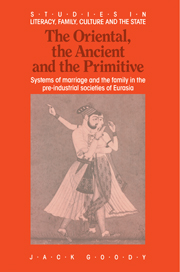 The Oriental, the Ancient and the Primitive
The Oriental, the Ancient and the Primitive Book contents
- Frontmatter
- Contents
- List of illustrations
- List of tables
- Preface
- 1 The nature of the enterprise
- PART I CHINA
- PART II INDIA
- PART III THE NEAR EAST
- 10 The abominations of the Egyptians
- 11 Jacob's marriages
- 12 Marriage and property in the Arab world
- PART IV GREECE AND ROME, YESTERDAY AND TODAY
- Notes
- References
- Index
12 - Marriage and property in the Arab world
Published online by Cambridge University Press: 09 January 2010
- Frontmatter
- Contents
- List of illustrations
- List of tables
- Preface
- 1 The nature of the enterprise
- PART I CHINA
- PART II INDIA
- PART III THE NEAR EAST
- 10 The abominations of the Egyptians
- 11 Jacob's marriages
- 12 Marriage and property in the Arab world
- PART IV GREECE AND ROME, YESTERDAY AND TODAY
- Notes
- References
- Index
Summary
The Arab world constitutes a vast domain in time and space, but one which displays some remarkable similarities through the application of Islamic law and custom. Nevertheless there are considerable differences not only among the various schools and regions but in particular between the nomadic Bedouin of the desert, with their ‘tribal’ organisation based on the solidarity of the lineage, and the settled populations, the peasantry in the villages, some with tribal affiliations, and the merchants in the towns. Clearly different strategies of heirship obtain among nomadic peoples, where land was indivisible and held largely in common and where livestock are easily split up into smaller but self-reproducing parcels, than in rural or urban situations where rights in land, in houses or in enterprises have to be reallocated in rather different ways.
This tripartite division of the population is neither new nor confined to the Arabs, but goes back to the coming of agriculture to West Asia, long before the coming of Islam. Both the continuity and the diversity have to be borne constantly in mind when thinking of kinship, marriage and the family among the Arabs from, say, the fourth century AD. For there is once again a tendency to foreshorten the historical sequence, and in particular to look upon Mohammed himself as a point of transition between the tribal and the settled, between the solidarity ('asabiyya) of the desert lineages and the domestic, familial patterns of the town and even of the settled, farming hinterland.
- Type
- Chapter
- Information
- The Oriental, the Ancient and the PrimitiveSystems of Marriage and the Family in the Pre-Industrial Societies of Eurasia, pp. 361 - 382Publisher: Cambridge University PressPrint publication year: 1990


